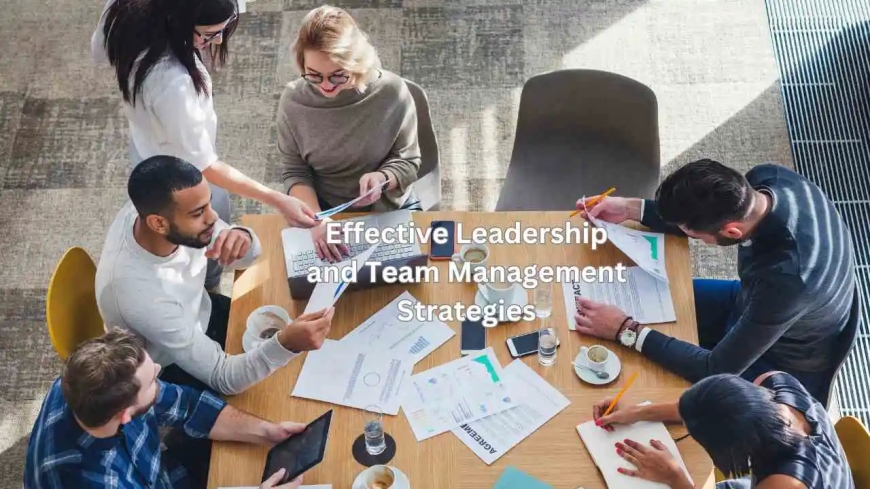Effective Leadership and Team Management Strategies, such as Encouraging Teamwork
Leadership and teamwork skills are essential because they enable organizations to achieve their goals efficiently and effectively. In essence, the combination of strong leadership and teamwork creates a cohesive, high-performing organization capable of achieving sustainable success.

Effective leadership provides direction, motivation, and support, which fosters a positive work environment and encourages employees to perform at their best. Good leaders inspire trust and confidence, making navigating challenges and adapting to changes easier.
Teamwork skills, on the other hand, promote collaboration and cooperation among team members. When individuals work together effectively, they combine their diverse skills and perspectives to solve problems more creatively and efficiently. This synergy enhances productivity and innovation, leading to better outcomes for the organization.
Furthermore, strong teamwork fosters a sense of belonging and shared purpose, which can improve job satisfaction and employee retention. Here are some key strategies:
1. Encouraging Teamwork
Clear Goals and Roles: Ensure each team member understands their responsibilities and how they contribute to the team’s objectives. This clarity helps in aligning individual efforts with the team’s goals.
Open Communication: Foster an environment where team members feel comfortable sharing ideas, feedback, and concerns. Regular check-ins and open forums for discussion can help maintain transparency and trust.
Collaboration Tools: Utilize collaboration tools and technologies that facilitate seamless communication and coordination among team members. Tools like Slack, Microsoft Teams, and project management software can be very effective.
Inclusive Leadership: Promote inclusivity by valuing diverse perspectives and encouraging all team members to participate in decision-making processes. This approach can lead to more innovative solutions and a stronger sense of ownership among team members.
2. Building Psychological Safety
Encourage Risk-Taking: Create a safe environment where team members feel comfortable taking risks and making mistakes. This can lead to greater innovation and learning within the team.
Recognize Efforts: Regularly acknowledge and appreciate the contributions of team members. This recognition can boost morale and motivation, making team members feel valued.
Provide Constructive Feedback: Offer specific, actionable feedback aimed at helping team members improve. Constructive feedback should be given in a supportive manner, focusing on behaviors rather than personal attributes.
Lead by Example: Demonstrate the behaviors and values you expect from your team. When leaders model transparency, accountability, and respect, it sets a standard for the entire team.
3. Motivation Techniques
Set Achievable Milestones: Break down larger projects into smaller, manageable tasks with clear milestones. Celebrating the completion of these milestones can keep the team motivated and maintain momentum.
Empower Team Members: Give team members the autonomy to make decisions related to their work. Empowerment can lead to increased job satisfaction and a greater sense of responsibility.
Provide Opportunities for Growth: Encourage continuous learning and professional development. Providing access to training, mentorship, and career advancement opportunities can motivate team members to excel.
4. Conflict Resolution
Address Conflicts Promptly: Tackle conflicts as soon as they arise to prevent them from escalating. Open communication and mediation can help resolve disputes amicably.
Promote Respectful Interactions: Encourage team members to interact with respect and professionalism. Establishing ground rules for behavior can help maintain a positive team dynamic.
5. Team Building Activities
Regular Team-Building Exercises: Organize activities that build trust and camaraderie among team members. These can range from informal social gatherings to structured team-building workshops.
Cross-Functional Projects: Involve team members in projects that require collaboration across different functions or departments. This can enhance understanding and cooperation within the organization.
6. Flexibility and Adaptability
Flexibility and adaptability are crucial in today's dynamic and ever-changing work environment. Flexibility refers to the ability to adjust and respond effectively to new circumstances, challenges, and demands. Incorporating flexibility and adaptability into the workplace can lead to numerous benefits. It enhances problem-solving capabilities by encouraging innovative thinking and openness to new ideas.
Teams that are flexible and adaptable can pivot strategies quickly in response to market changes or unforeseen challenges, maintaining a competitive edge. Moreover, these skills contribute to a positive work culture by reducing stress and fostering a sense of confidence among employees.
They feel more equipped to handle uncertainties and are more likely to embrace change as an opportunity rather than a threat. In essence, flexibility and adaptability are essential for both personal and organizational growth, helping to navigate the complexities of modern business landscapes and ensuring long-term success.

 LD Web Desk
LD Web Desk 